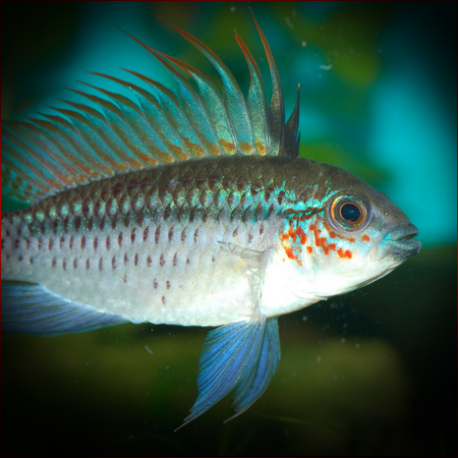More info
Datasheet
| Minimum Tank Size | 60 litres / 15.85 US gallons |
| Maximum Size | 7.0cm / 2.76inches |
| Temperature | 22°C / 71.60°F - 28°C / 82.40°F |
| Hardness | 1.01dgH / 18ppm - 5.04dgH / 90ppm |
| pH | 4.0-6.0 |
General Description
The Apistogramma Eremnopyge, also known by the code A218 under the DATZ system, is a species of cichlid classified under the Perciformes order. It is a small fish, with males being larger and more colorful than females. Easily recognizable by the dark blotch on the lower portion of the caudal peduncle in both sexes and the presence of a relatively narrow lateral stripe. This species is primarily carnivorous, feeding on benthic invertebrates in nature.
Aquarium Setup
For optimal aquarium setup, provide enough cover and structure, such as ceramic flowerpots or lengths of plastic piping, and natural decorations like wood roots and branches for caves. Dried leaf litter can be added for spawning sites and as a secondary food source for fry. Lighting should be dim, and aquatic plants like Microsorum, Taxiphyllum, or Cryptocoryne spp. can be included. Additionally, floating vegetation such as Ceratopteris spp. is beneficial. Soft water with low hardness and acidity levels are necessary, achieved through a reverse osmosis system if needed.
Behaviour
The Apistogramma Eremnopyge is best maintained alone or with small 'dither' fishes like Nannostomus species and is more suitable to be in a group with several males and up to three times as many females. If kept in pairs, the presence of other conspecific pairs in adjacent tanks can distract them from aggressive behavior towards each other.
Feeding and Diet
Chiefly carnivorous, this species feeds mainly on benthic invertebrates. In an aquarium setting, they should be offered live and frozen foods like Artemia, Daphnia, and chironomid larvae regularly. They can also learn to accept dried alternatives, with pelleted products being preferable.
Reproduction & Dimorphism
Apistogramma Eremnopyge is a substrate spawner, laying eggs in crevices among the decor. Males establish territories and can be aggressive towards other males. Spawning usually occurs in darkness or at dawn, with females guarding the eggs and fry. Males typically have more extended fins, are larger, and more colorful than females.
Habitat and Distribution
This species is found in the Loreto region of northeastern Peru, specifically in slower-moving tributaries, backwaters, and creeks with very soft, clear, or black water where fallen leaf litter collects. It has been recorded in the Rio Pintuyacu, Iquitos, Nauta, and the Nanay system. Another population exists in the Rio Tapiche, a tributary of the Rio Ucayali located further south.

